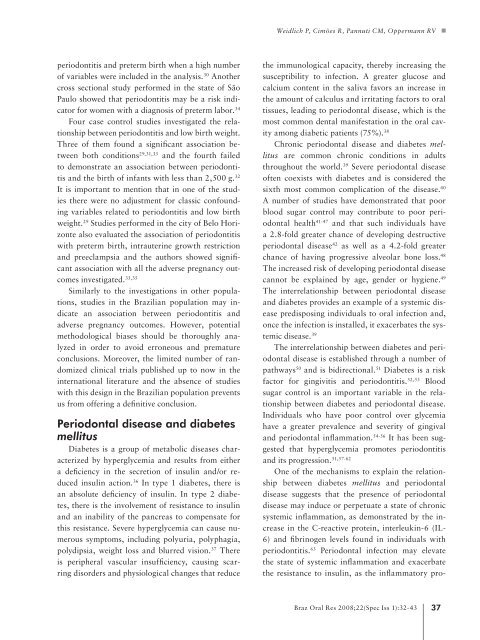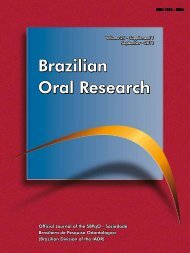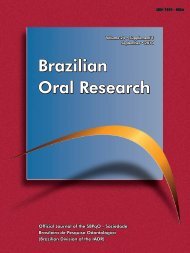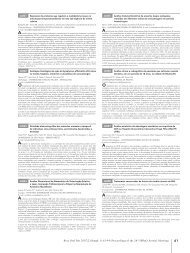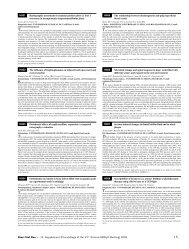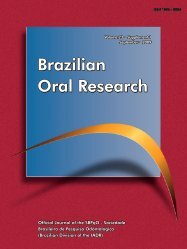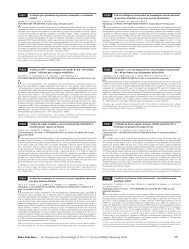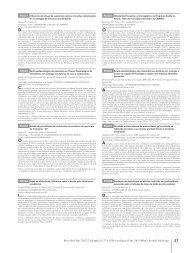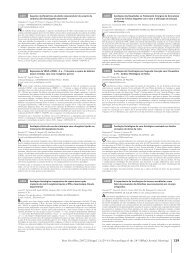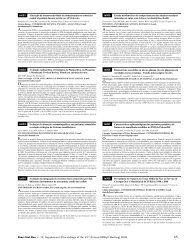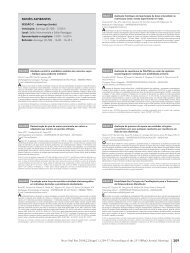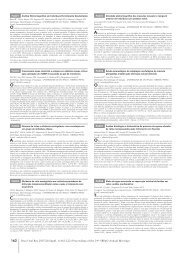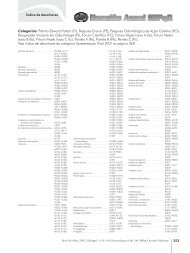Brazilian Oral Research Brazilian Oral Research Brazilian Oral
Brazilian Oral Research Brazilian Oral Research Brazilian Oral
Brazilian Oral Research Brazilian Oral Research Brazilian Oral
Create successful ePaper yourself
Turn your PDF publications into a flip-book with our unique Google optimized e-Paper software.
periodontitis and preterm birth when a high number<br />
of variables were included in the analysis. 30 Another<br />
cross sectional study performed in the state of São<br />
Paulo showed that periodontitis may be a risk indicator<br />
for women with a diagnosis of preterm labor. 34<br />
Four case control studies investigated the relationship<br />
between periodontitis and low birth weight.<br />
Three of them found a significant association between<br />
both conditions 29,31,33 and the fourth failed<br />
to demonstrate an association between periodontitis<br />
and the birth of infants with less than 2,500 g. 32<br />
It is important to mention that in one of the studies<br />
there were no adjustment for classic confounding<br />
variables related to periodontitis and low birth<br />
weight. 29 Studies performed in the city of Belo Horizonte<br />
also evaluated the association of periodontitis<br />
with preterm birth, intrauterine growth restriction<br />
and preeclampsia and the authors showed significant<br />
association with all the adverse pregnancy outcomes<br />
investigated. 33,35<br />
Similarly to the investigations in other populations,<br />
studies in the <strong>Brazilian</strong> population may indicate<br />
an association between periodontitis and<br />
adverse pregnancy outcomes. However, potential<br />
methodological biases should be thoroughly analyzed<br />
in order to avoid erroneous and premature<br />
conclusions. Moreover, the limited number of randomized<br />
clinical trials published up to now in the<br />
international literature and the absence of studies<br />
with this design in the <strong>Brazilian</strong> population prevents<br />
us from offering a definitive conclusion.<br />
Periodontal disease and diabetes<br />
mellitus<br />
Diabetes is a group of metabolic diseases characterized<br />
by hyperglycemia and results from either<br />
a deficiency in the secretion of insulin and/or reduced<br />
insulin action. 36 In type 1 diabetes, there is<br />
an absolute deficiency of insulin. In type 2 diabetes,<br />
there is the involvement of resistance to insulin<br />
and an inability of the pancreas to compensate for<br />
this resistance. Severe hyperglycemia can cause numerous<br />
symptoms, including polyuria, polyphagia,<br />
polydipsia, weight loss and blurred vision. 37 There<br />
is peripheral vascular insufficiency, causing scarring<br />
disorders and physiological changes that reduce<br />
Weidlich P, Cimões R, Pannuti CM, Oppermann RV<br />
the immunological capacity, thereby increasing the<br />
susceptibility to infection. A greater glucose and<br />
calcium content in the saliva favors an increase in<br />
the amount of calculus and irritating factors to oral<br />
tissues, leading to periodontal disease, which is the<br />
most common dental manifestation in the oral cavity<br />
among diabetic patients (75%). 38<br />
Chronic periodontal disease and diabetes mellitus<br />
are common chronic conditions in adults<br />
throughout the world. 39 Severe periodontal disease<br />
often coexists with diabetes and is considered the<br />
sixth most common complication of the disease. 40<br />
A number of studies have demonstrated that poor<br />
blood sugar control may contribute to poor periodontal<br />
health 41-47 and that such individuals have<br />
a 2.8-fold greater chance of developing destructive<br />
periodontal disease 42 as well as a 4.2-fold greater<br />
chance of having progressive alveolar bone loss. 48<br />
The increased risk of developing periodontal disease<br />
cannot be explained by age, gender or hygiene. 49<br />
The interrelationship between periodontal disease<br />
and diabetes provides an example of a systemic disease<br />
predisposing individuals to oral infection and,<br />
once the infection is installed, it exacerbates the systemic<br />
disease. 39<br />
The interrelationship between diabetes and periodontal<br />
disease is established through a number of<br />
pathways 50 and is bidirectional. 51 Diabetes is a risk<br />
factor for gingivitis and periodontitis. 52,53 Blood<br />
sugar control is an important variable in the relationship<br />
between diabetes and periodontal disease.<br />
Individuals who have poor control over glycemia<br />
have a greater prevalence and severity of gingival<br />
and periodontal inflammation. 54-56 It has been suggested<br />
that hyperglycemia promotes periodontitis<br />
and its progression. 51,57-62<br />
One of the mechanisms to explain the relationship<br />
between diabetes mellitus and periodontal<br />
disease suggests that the presence of periodontal<br />
disease may induce or perpetuate a state of chronic<br />
systemic inflammation, as demonstrated by the increase<br />
in the C-reactive protein, interleukin-6 (IL-<br />
6) and fibrinogen levels found in individuals with<br />
periodontitis. 63 Periodontal infection may elevate<br />
the state of systemic inflammation and exacerbate<br />
the resistance to insulin, as the inflammatory pro-<br />
Braz <strong>Oral</strong> Res 2008;22(Spec Iss 1):32-43


